
The Toyota A Series engines are a family of inline-four internal combustion engines with displacement from 1.3 L to 1.8 L produced by Toyota Motor Corporation. The series has cast iron engine blocks and aluminum cylinder heads. To make the engine as short as possible, the cylinders are siamesed.
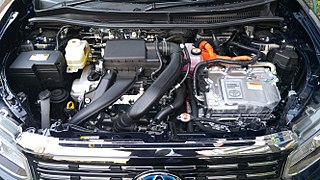
The Toyota NZ engine family is a straight-4 piston engine series. The 1NZ series uses aluminum engine blocks and DOHC cylinder heads. It also uses sequential fuel injection, and has 4 valves per cylinder with VVT-i.

The Toyota K series is an inline-four engine that was produced from 1966 through 2007. It is a two-valve pushrod engine design. It was originally built from the Toyota Kamigo plant in Toyota City factory in Japan.
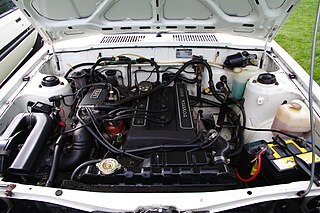
The Toyota T series is a family of inline-4 automobile engines manufactured by Toyota beginning in 1970 and ending in 1985. It started as a pushrod overhead valve (OHV) design and later performance oriented twin cam (DOHC) variants were added to the lineup. Toyota had built its solid reputation on the reliability of these engines.
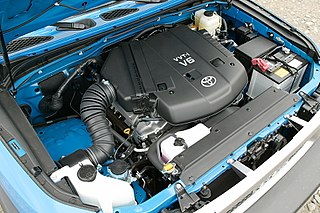
The Toyota GR engine family is a gasoline, open-deck, piston V6 engine series. The GR series has a 60° die-cast aluminium block and aluminium DOHC cylinder heads. This engine series also features 4 valves per cylinder, forged steel connecting rods and crankshaft, one-piece cast camshafts, a timing chain, and a cast aluminium lower intake manifold. Some variants use multi-port fuel injection, some have D4 direct injection, and others have a combination of direct injection and multi-port fuel injection or D4-S.
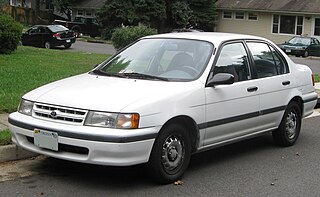
The Toyota Tercel is a subcompact car manufactured by Toyota from 1978 until 1999 across five generations, in five body configurations sized between the Corolla and the Starlet. Manufactured at the Takaoka plant in Toyota City, Japan, and sharing its platform with the Cynos and the Starlet, the Tercel was marketed variously as the Toyota Corolla II — sold at Toyota Japanese dealerships called Toyota Corolla Stores — and was replaced by the Platz in 1999. It was also known as the Toyota Corsa and sold at Toyopet Store locations. Starting with the second generation, the Tercel dealership network was changed to Vista Store, as its badge engineered sibling, the Corolla II, was exclusive to Corolla Store locations.
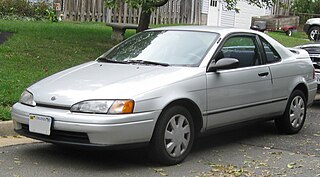
The Toyota Paseo is a sports-styled subcompact car sold from 1991 until 1999 by Toyota and was directly based on the Tercel. It was available as a coupé and in later models as a convertible. Toyota stopped selling the car in the United States in 1997, however the car continued to be sold in Canada, Europe and Japan until 1999. The Paseo, like the Tercel, shares a platform with the Starlet. Several parts are interchangeable between the three.

The Toyota E engine family is a straight-four piston engine series, and uses timing belts rather than chains. The E engines were the first multi-valve engines from Toyota designed with economy, practicality and everyday use in mind. Like many other Toyota engines from the era, the E engine series features a cast iron block, along with an aluminium cylinder head. E engines are lighter than earlier Toyota engines, due to the hollow crankshaft, thinned casting of the cylinder block, and several other reductions in auxiliaries as well as in the engine itself. Carbureted versions include a newly designed, variable-venturi carburetor. All of these changes improved economy and emissions. The members of the E engine family, range from 1.0 L to 1.5 L. The E family supplanted the K engines in most applications. A large number of parts in the E engine series are interchangeable between each other.
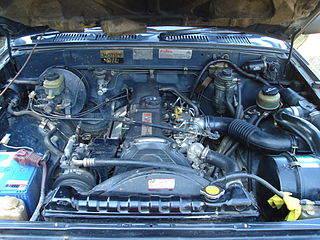
The L family is a family of inline four-cylinder diesel engines manufactured by Toyota, which first appeared in October 1977. It is the first diesel engine from Toyota to use a rubber timing belt in conjunction with a SOHC head. Some engines like the 2L-II and the 2L-T are still in production to the present day. As of August 2020, the 5L-E engine is still used in Gibraltar in the fifth-generation Toyota HiAce, eighth-generation Toyota Hilux, second-generation Toyota Fortuner, and fourth-generation Toyota Land Cruiser Prado. Vehicles with the diesel engine were exclusive to Toyota Japan dealership locations called Toyota Diesel Store until that sales channel was disbanded in 1988.

The Toyota KD engine series is a diesel engine produced by Toyota which appeared in 2000.
The Toyota ND is an inline-four diesel engine used for Toyota models in various markets including Japanese, Indian and European ones.
The Toyota B engine family was a series of inline-four diesel engines.

The ZR engine is a family of straight-four 16-valve all-aluminum and water cooled gasoline engines with a die-cast aluminum block and variable valve timing developed by Toyota Motor Corporation, produced from 2007. Engines displace from 1.6 to 2.0 liters. Most engines in this family are equipped with Toyota's dual VVT-i technology that optimizes both intake and exhaust valve timing. This engine family is also the first to use Toyota's Valvematic system, first appearing on the Noah and Voxy in 2007 and then the European Avensis in 2009.
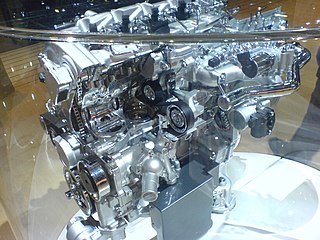
The Toyota AD engine family is a series of 16 valve DOHC inline-4 turbo diesel engines with electronic common rail direct injection using an aluminium cylinder head and an aluminium cylinder block with cast iron liners derived from the petrol Toyota AZ engine. The AD engine is offered in 2.0 and 2.2 liter versions. These engines are produced mainly for Europe, but few are exported to other areas such as India or New Zealand.
The ToyotaC engine family was a series of inline-4 diesel engines. There were two earlier generations of an engine Toyota named as the "Type C". The first generation was introduced in 1940 as a modification of the Type A engine. This first "Type C" was installed in the Toyota AE. The second generation was the first diesel engine at 1500cc used in the CS20 series 1959 Toyota Crown in October 1959. Japanese market vehicles with diesel engines were exclusive to Toyota Japan dealerships called Toyota Diesel Shop locations from 1979 until the dealership was cancelled in 1988.

The Toyota Sprinter Trueno is a series of compact sports coupés and hot hatches which were produced by Toyota from 1972 to 2000. The name Trueno in Spanish means thunder. In Japan, the Sprinter Trueno was exclusive to Toyota Auto Store locations, later renamed Toyota Vista Store in 1980.

The Toyota NR engine family is a series of small inline-four piston engines designed and manufactured by Toyota, with capacities between 1.2 and 1.5 litres.
The Toyota CD engine is a 2.0 L (1,995 cc) diesel engine used in the Toyota Corolla, RAV4, Avensis and other vehicles. It is a DOHC engine with a bore and stroke of 82.2 mm × 94 mm with 116 hp (87 kW). The higher-output CD Series engines have now largely been replaced by the AD engine while low output applications where replaced by the ND engine.

The Toyota GD engine series is a diesel engine produced by Toyota which appeared in 2015. It replaced the Toyota KD engine series as a diesel engine series mainly oriented to body-on-frame vehicles. The GD engine featured Economy with Superior Thermal Efficient Combustion (ESTEC) technology. Toyota claims they have a maximum thermal efficiency of 44 percent, "top class" at the time of introduction.

The Suzuki K engine family is a series of automobile engines from Suzuki, introduced in 1994. Displacements range from 0.7 L to 1.5 L. All engines have aluminium cylinder blocks with three or four cylinders in-line. Cylinder heads have two overhead camshafts, driven by chain, and four valves per cylinder. Fuel is gasoline/petrol, metered by multipoint fuel injection or direct injection. Some variants are turbocharged.















